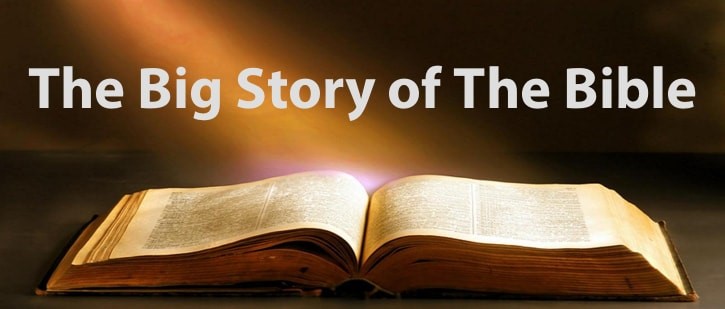This is Part 2 of a musing from a conversation I had this week. For Part 1 see the weekly e news also on this website
In our conversation, once we had talked about the difference between spirituality, theology and religion, we segued on to the flow of the Christian Story, as laid out in the biblical narrative. When we had finished, it seemed like a reasonable summary which made sense of individual stories and items which we tend to hear piecemeal in church from time to time. So here it is. Harder to write down than to speak, but I’ll give it a go. How about ‘The Biblical Narrative in 1000 words’ ?
First there’s the attempt to describe the world coming be to through Creation stories in Genesis. This is coupled with an attempt to describe how relationship between humans and the divine started. This story involves fruit, a serpent, Eve and Adam and a tree. In traditional terms now human beings are thought of as ‘falling’ into wrong, a tendency we’re all said to inherit simply by being human. On the other hand, it can be interpreted as a choice for ‘Eve’ and ‘Adam’ whether to remain childishly innocent, luxuriating in paradise OR to reach out for the knowledge of good and evil and ‘grow up’. By doing so they become adult, conscious of good and bad, able to face consequences; experiencing pain, working for a living, not bludging off the landlord of Paradise Hotel.
Then the Bible turns to patriarchal history -Abraham to Isaac to Jacob to Joseph. (Yes, there were women – another blog). After Joseph, the Hebrews are an immigrant problem for Egypt. Subsequently a dramatic legend grew around the leaving of Egypt for that much-fought-over Promised Land on the Mediterranean. The book of Exodus is this expanded narrative, thought to have been strengthened and embellished over years to a founding metaphor of the Israelite nation. The theological world view is of a people delivered by God to whom gratitude is owed.
The dramatic apex of release from oppression is symbolised by lamb’s blood identifying safe houses where first- born sons would NOT be killed (see beginning of Exodus). This founding event, (commemorated by devout Jews each Friday night Shabbat and annual Passover), sets the scene for salvation to be seen as through sacrifice – by the blood of a lamb. (Not surprisingly, much, much later, Jesus’ death seems similar, so ‘Lamb of God’ is used to describe Jesus. This made sense to first century Jews, though little sense to twenty-first century Gentiles.)
Meanwhile, the book of Exodus describes this movement out of Egypt. Three other books of Torah (law) follow, which set out, if you like, the constitution of the new nation, its founding history and theology and rules and regulations. The Israelites were first ruled by Joshua, then several Judges (hence books of Joshua and Judges) then by kings (hence 1st and 2nd Kings) – when Saul, then David then Solomon ruled a single kingdom assisted by prophets like Samuel (hence 1 and 2 Samuel). Solomon built on the Temple mound in Jersualem. After his death, the kingdom split – into Judah (north) and Israel (south). Successive conquering waves of empires (who greatly desired control of this key land through which trade routes ran) flowed through both Judah and Israel. In 586 BCE, after Babylon, (conqueror of the moment), destroyed the Temple and took many Jews to Babylon (modern Baghdad). Fighting recorded in the Hebrew Bible (our ‘Old Testament’) is these imperial incursions visited on the Hebrews by Hittites, Assyrians, Persians…etc., the empires of the day.
The destruction of the Temple was a theological crisis. Boney M paraphrased the Jew’s despairing psalm. “How can we sing the Lord’s song in a strange land?” they cried? If God was in the temple, and the temple was no more, where was God? They were refugees, captives AND a people bereft of their God. So alongside Exodus, Exile joins Jewish theological self-understanding. They are a people of the exile, later returned by Babylon to rebuild their city and temple, but a very different kind of people, now worshipping in local synagogues.
After a section of wisdom writing which includes the book of Job, Psalms, Proverbs, Ecclesiastes, and Lamentations the rest of the books in the Hebrew Bible are collections of prophetic writings, delivered to the people and rulers at different stages, so referring to varying contexts – war, famine, prosperity – at different times. These snapshots reflect successive stages of the national faith journey. In times of peril they long for another deliverance. A legendary figure begins to form, the Messiah for whom they wait in great anticipation – this person who will save the people.
Out of that matrix and self-understanding Jesus arises. He is another wise teacher, but with an authority different from others. His enigmatic sayings benefit from a symbolic analysis to gain their deeper meanings. The four Gospels give differing views of his sayings, sometimes contradicting, sometimes complementing each other. He challenges the orthodoxy of the time and urges freeing up the religious system of the day which had become rule-bound. This is not popular and a devious collusion of ecclesiastical Jewish and imperial Roman power brings about his death by crucifixion.
Jesus’ followers carry on his message, after his death recognising him as the long awaited Messiah, or Anointed One, (also as the Lamb of God). Their early experiences are described in the Acts of the Apostles, then the rest of the Bible is a collection of letters written to the early groupings springing up around the Mediterranean or both Jewish and Gentile followers of the ‘Jesus Way’. This is grandly referred to as the Early Church but comprised small house groups and secret gatherings. There were ‘churches’ such as these in Rome (Letter to the Romans), Corinth (1 and 2 Corinthians), Galatian (Galatians), Ephesus (Ephesians,) Philippi, (Philippians), Colossus (Colossians), Thessalonica (Thessalonians). Letters were also named for their authors: Peter and James and John.
These letters give us only half of the conversation but paint a picture of pockets of faith and commitment which slowly get to know more about each other through letters and travelling teachers. Life was rough at first as the new sect was first cut off from the Jewish religion around 70 AD. Then Jesus followers were viewed very suspiciously and persecuted by the Roman empire until the emperor Constantine adopted Christianity as the state religion. Opinion is greatly divided as to whether this was a favour to Christianity or a fateful altering of its purpose. It is perhaps at this point Christianity could be said to move from being a spiritual movement to an organised religion. (1000!)
This may pull together formerly disconnected items of religion history, spiritual encounters and theological mysteries. I hope so! Whatever the shape of our Stories or our story, I believe Love surrounds us every moment of every day.
Susan


